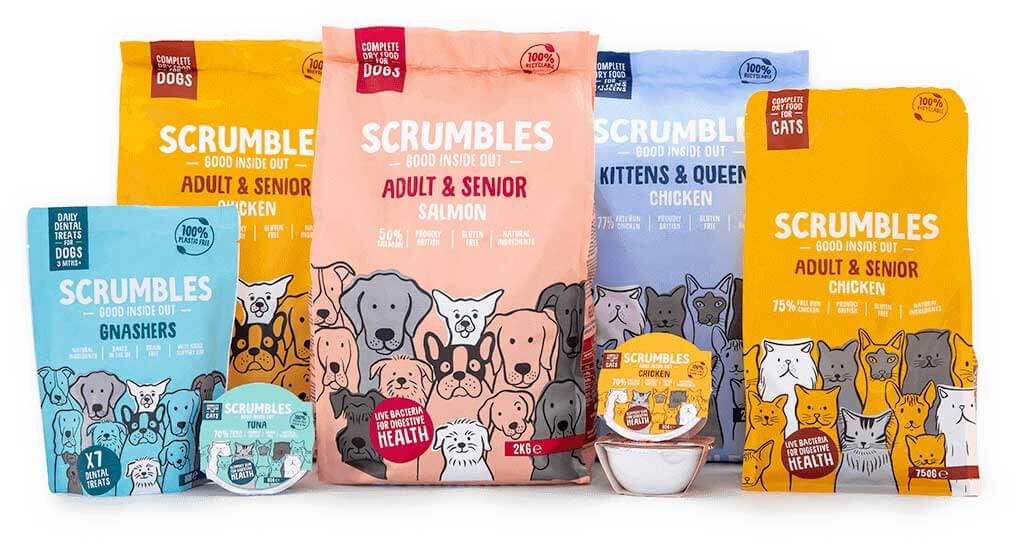6 benefits of Slippery Elm For Dogs and Cats
Is it a bird? Is it a plane? No, it's slippery elm! Whilst not quite superman, slippery elm is the super ingredient we use in all our wet food and treats. It's a natural prebiotic, derived from the bark of a tree, that's well-renowned for its tummy-soothing and gut-friendly qualities.

Today we're deep-diving into what slippery elm is, and why we use it. Starting off by exploring its origin, followed by the role it plays as a prebiotic, and finally the 6 main benefits of slippery elm for dogs and cats. As well as how you can include it into your floofs diet easily, aka a tasty Scrumbles treato!
Where does slippery elm come from?
Slippery Elm, or by it's genus Ulmus rubra, is a tree native to Northeastern America. You might have also heard it called Indian Elm, Red Elm or even Gray Elm - how many nicknames does a tree need? It's been used for centuries by Native Americans, and today by pets and their hoomans alike. Attempts have even been made to grow it in the UK, but have been unsuccessful to date.
The specific part that's used for its medicinal benefit is the inner bark. This is extracted by removing the bark in strips, and scraping the inner part away, which is then dried. Typically done around March to June, when it comes away most easily.
Slippery elm is a prebiotic
Slippery elm is considered a prebiotic because once it's consumed, it becomes a source of food for the bacteria in your pet's gut, as they can't digest it themselves. Or if you'd like a slightly more scientific meaning prebiotics are "“nondigestible food ingredients that selectively stimulate the growth and activities of specific bacteria in the gastrointestinal tract and exert beneficial effects on the host.”, Pan, 2019.
We often get asked what the difference is between prebiotics and probiotics. So just to clarify, probiotics are microorganisms found in your pet's body. You might have heard them referred to as “good” or “friendly” bacteria. They can also be added to your pet's diet, for example via a healthy probiotic cat food or probiotic dog food.
6 benefits of slippery elm for dogs and cats?
Whilst more studies are required to understand the benefits of slippery elm in full, those carried out so far have shown a positive impact on everything from gut flora to nutrient absorption. Let's go into a little more detail on 5 of the main benefits...
1. Healthy Digestion
As we now know, slippery elm is a prebiotic, which means it helps support normal gut function by feeding the bacteria in your pet's gut. The role that these bacteria then go on to play aren't fully understood, but are so integral they're thought to impact almost every bodily function. From healthy digestion to even your pet's mental health. Happy gut = happy doggy or cat!
2. Immune function
Did you know approximately 70% of your fur babies immune system resides in the gut? This is because it's where the majority of potentially harmful bacteria can enter their (and your) body. Slippery elm is thought to contribute to immune function by lining the gut with a viscous layer that both protects the gut lining, and can trap bad bacteria in the mucus.
3. Pretty Poops
Heavily linked to healthy digestion, slippery elm could also help you on your quest for the perfect poop! It's often used for treating short term incidences of diarrhea or constipation, by forming that vicious membrane we just mentioned, which lubricates the tract and helps move 'things' along smoothly. ('Things' being poops!)
4. Nutrient Absorption
By feeding the gut flora, slippery elm is also thought to be able to help your floof absorb nutrients like calcium more efficiently.
5. Weight Management
Researchers have found that slippery elm may help contain blood sugar levels, which helps maintain a moderate weight.
6. Chronic Pancreatitis
Finally slippery elm can also be beneficial to pets that suffer from chronic pancreatitis. This is a condition caused by obesity and high-fat diets, amongst others, which results in an inability to digest food properly. Slippery elm helps by easing symptoms and protecting the damaged tissue. If you're on the hunt for a recipe suitable for dogs with pancreatitis, don't miss our Salmon Dry Dog Food or Gnashers Dental Bones.
How to include slippery elm into your pet's diet?
Slippery elm comes in a number of forms including tablets, powders, or within food. We know how difficult it can be getting your floof to eat a tablet, so we include slippery elm into all our tasty cat and dog wet food and treats recipes. So they won't even know it's there!
For doggies this includes our complete and grain free Chicken Dog Food, Salmon or Turkey. Then all our dog treats; Plant-Powered or Meaty Training Treats, Gnashers Dental Bones or our Calming Nibbles.
Then for kitties you have the choice of our Turkey, Salmon, Tuna or Chicken grain free wet cat food, or Gnashers Dental Bites.

When should pet's not consumer slippery elm
Slippery elm is a natural ingredient that is suitable for all breeds and life stages. However, as studies are still limited, the VCA recommends not to feed slippery elm to pets that are allergic to it (very rare), pregnant, or nursing.
Given in the wrong quantity anything can have potentially harmful consequences, which is why we design all our recipes according to strict FEDIAF guidelines. Which includes having the correct dose of slippery elm to help your fur friend thrive!
Whilst you're hear, why not read:
- Probiotics for dogs; aka the journey to the perfect poo!
- Dreamies Cat Treats; are they good or bad?
- Probiotics for cats; what are the benefits









